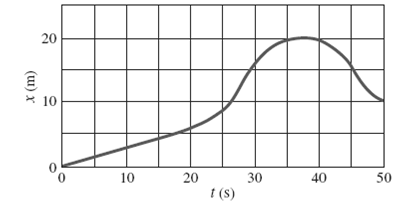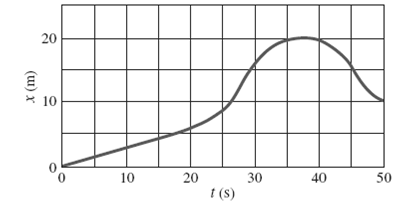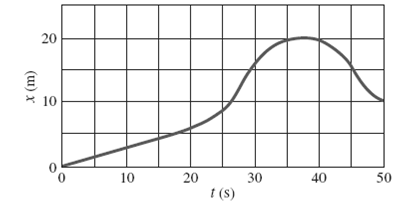
Concept explainers
(a)
The time period when the velocity is constant.
(a)
Answer to Problem 51P
Velocity is constant in
Explanation of Solution
Given:
The given graph is shown below.

Formula Used:
Velocity is calculated as
Calculation:
Constant velocity is obtained by deducing the slope of the distance-time graph. Here, velocity is constant in the starting period of
Conclusion:
Velocity is constant in
(b)
The time when the velocity is greatest.
(b)
Answer to Problem 51P
Velocity is maximum at
Explanation of Solution
Given:
The given graph is shown below.

Calculation:
Velocity is maximum at its peak when the slope would be highest positive. For the given graph, the slope is highestat
Conclusion:
Velocity is maximum at
(c)
The time when the velocity is zero.
(c)
Answer to Problem 51P
Velocity will be zero at
Explanation of Solution
Given:
The given graph is shown below.

Calculation:
Velocity will be zero when the instantaneous position of the object will be zero that is when the graph is at the highest possible value at
Conclusion:
Velocity will be zero at
(d)
To identify: Whether the object will move in one direction or both directions during the time shown.
(d)
Answer to Problem 51P
The object will move forward in
Explanation of Solution
Given:
The given graph is shown below.

Calculation:
As shown in the graph, the object moves in both positive and negative direction. When the slope is positively increasing then the object will move in the forward direction in
Conclusion:
The object will move forward in
Chapter 2 Solutions
Physics: Principles with Applications
Additional Science Textbook Solutions
Physics for Scientists and Engineers with Modern Physics
Physics for Scientists and Engineers: A Strategic Approach, Vol. 1 (Chs 1-21) (4th Edition)
Essential University Physics: Volume 1 (3rd Edition)
College Physics (10th Edition)
Lecture- Tutorials for Introductory Astronomy
 College PhysicsPhysicsISBN:9781305952300Author:Raymond A. Serway, Chris VuillePublisher:Cengage Learning
College PhysicsPhysicsISBN:9781305952300Author:Raymond A. Serway, Chris VuillePublisher:Cengage Learning University Physics (14th Edition)PhysicsISBN:9780133969290Author:Hugh D. Young, Roger A. FreedmanPublisher:PEARSON
University Physics (14th Edition)PhysicsISBN:9780133969290Author:Hugh D. Young, Roger A. FreedmanPublisher:PEARSON Introduction To Quantum MechanicsPhysicsISBN:9781107189638Author:Griffiths, David J., Schroeter, Darrell F.Publisher:Cambridge University Press
Introduction To Quantum MechanicsPhysicsISBN:9781107189638Author:Griffiths, David J., Schroeter, Darrell F.Publisher:Cambridge University Press Physics for Scientists and EngineersPhysicsISBN:9781337553278Author:Raymond A. Serway, John W. JewettPublisher:Cengage Learning
Physics for Scientists and EngineersPhysicsISBN:9781337553278Author:Raymond A. Serway, John W. JewettPublisher:Cengage Learning Lecture- Tutorials for Introductory AstronomyPhysicsISBN:9780321820464Author:Edward E. Prather, Tim P. Slater, Jeff P. Adams, Gina BrissendenPublisher:Addison-Wesley
Lecture- Tutorials for Introductory AstronomyPhysicsISBN:9780321820464Author:Edward E. Prather, Tim P. Slater, Jeff P. Adams, Gina BrissendenPublisher:Addison-Wesley College Physics: A Strategic Approach (4th Editio...PhysicsISBN:9780134609034Author:Randall D. Knight (Professor Emeritus), Brian Jones, Stuart FieldPublisher:PEARSON
College Physics: A Strategic Approach (4th Editio...PhysicsISBN:9780134609034Author:Randall D. Knight (Professor Emeritus), Brian Jones, Stuart FieldPublisher:PEARSON





